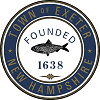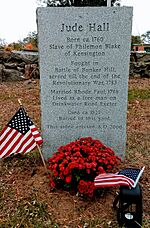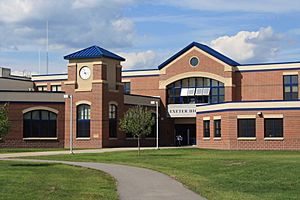Exeter, New Hampshire facts for kids
Quick facts for kids
Exeter, New Hampshire
|
||
|---|---|---|
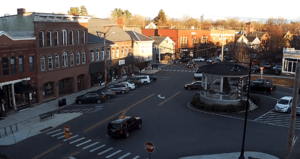
Water Street in downtown Exeter
|
||
|
||
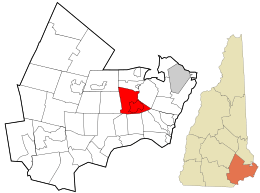
Location in Rockingham County and the state of New Hampshire
|
||
| Country | United States | |
| State | New Hampshire | |
| County | Rockingham | |
| Settled | April 3, 1638 | |
| Incorporated | 1638 | |
| Area | ||
| • Total | 20.0 sq mi (51.7 km2) | |
| • Land | 19.6 sq mi (50.8 km2) | |
| • Water | 0.3 sq mi (0.9 km2) 1.80% | |
| Elevation | 33 ft (10 m) | |
| Population
(2020)
|
||
| • Total | 16,049 | |
| • Density | 819/sq mi (316.1/km2) | |
| Time zone | UTC-5 (Eastern) | |
| • Summer (DST) | UTC-4 (Eastern) | |
| ZIP code |
03833
|
|
| Area code(s) | 603 | |
| FIPS code | 33-25380 | |
| GNIS feature ID | 0873595 | |
Exeter is a town in Rockingham County, New Hampshire, United States. In 2020, about 16,049 people lived there. This was more than the 14,306 people counted in 2010.
Exeter used to be the main town for county offices until 1997. Those offices then moved to Brentwood. Exeter is home to Phillips Exeter Academy, a private school that helps students get ready for college. The town is located where the Exeter River meets the Squamscott River.
Contents
A Look Back: Exeter's History

For thousands of years, the area where Exeter is now was home to the Pennacook Abenaki people. They called the place "M'Squamskook." This name meant "Falls at the Place of the Salmon" in their language. Later, it became known as "Squamscott."
About 100 Pennacook people would come back to the Squamscott area each spring. They would fish for salmon at the falls. They also grew corn and pumpkins. The town of Exeter grew up around these important fishing spots.
How Exeter Was Settled in 1638
On April 3, 1638, a religious leader named John Wheelwright bought the land. He had been sent away from the Massachusetts Bay Colony. Wheelwright and about 175 people started a new town. He named it Exeter, after a town in England.
At first, Exeter's local government was connected to Massachusetts. But in 1679, New Hampshire became its own colony. Exeter was one of the first four towns in the new province. It originally included areas that are now Newmarket, Newfields, Brentwood, Epping, and Fremont.
On July 4, 1639, 35 free men in Exeter signed a paper called the Exeter Combination. This document helped them set up their own government. The settlers hunted, farmed, and fished. They also raised animals and made wood products like shingles.
Thomas Wilson built the town's first grist mill (a mill for grinding grain). It was on the eastern side of the island in the lower falls. His son, Humphrey, took over the mill in 1643.
The Gilman Family's Influence
Some of the first settlers came from Hingham, Massachusetts. These included the Gilman, Folsom, and Leavitt families. In 1647, Edward Gilman Jr. started the first sawmill. By 1651, he had a large boat called a sloop. He used it to trade lumber and other goods.
Edward Gilman Jr. was lost at sea in 1653. But his family became very important in Exeter. They were known as lumbermen, shipbuilders, and traders. The Gilman Garrison House and the American Independence Museum were once homes of the Gilman family. The Gilmans also gave the land where Phillips Exeter Academy stands. Many members of the Gilman family served in the United States government. This included Founding Father Nicholas Gilman.
The Gilman family began trading with places as far away as the West Indies. They owned ships that sailed from Portsmouth. In 1803, one of their ships, the Oliver Peabody, was stopped by ships from the British Royal Navy. This happened during a blockade against the French. The British Admiral Horatio Nelson even paid the ship's captain for his cargo. This shows how far Exeter's traders traveled.
Exeter in the 1700s
The last attack by Native Americans on Exeter happened in August 1723. By 1725, the tribes had left the area. In 1774, the New Hampshire Provincial Congress started meeting in Exeter. This was because the colonial governor had banned them from meeting in Portsmouth.
In July 1775, the Provincial Congress moved all the official records from Portsmouth to Exeter. Because of this, Exeter became the capital of New Hampshire. It remained the capital for 14 years.
Exeter had a notable African American community. In 1790, the first census showed 81 free African Americans living there. Many of them owned their own homes. This was the highest percentage of African Americans in any town in New Hampshire at that time. Many, like Jude Hall, gained their freedom by fighting in the American Revolutionary War. They often settled near the Squamscott River after the war. Jude Hall is buried in the Winter Street cemetery.
Exeter in the 1800s
Reverend Thomas Paul, a famous minister, was born in Exeter around this time. Later, in 1822, the poet James Monroe Whitfield was born. He was Jude Hall's nephew and fought against slavery.
In 1827, the Exeter Manufacturing Company was started. It used the river's water power to make cotton fabrics. Other businesses made shoes, saddles, and carriages. In 1840, the Boston & Maine Railroad came to town.
According to former governor Hugh Gregg, the United States Republican Party began in Exeter. This happened on October 12, 1853, at the Squamscott Hotel. Amos Tuck and other people who wanted to end slavery met secretly. Tuck suggested forming a new political party called "Republican." Abraham Lincoln, who became the first Republican president, visited Exeter in 1860. His son, Robert Todd Lincoln, was a student at Phillips Exeter Academy.
Exeter was also home to the Robinson Female Seminary. This school for girls was founded in 1867. Its main building, built in 1869, unfortunately burned down in 1961.
Exeter in the 1900s
The Squamscott River was very polluted in the 1940s. Joanna Pellerin, a local land trust president, said the river "stank." It was filled with dyes from factories and sewage.
In 1922, the mills in Exeter were affected by a large textile strike. Workers stopped working because of planned wage cuts and longer hours.
In September 1965, Exeter became part of UFO history. A teenager named Norman Muscarello and two police officers saw a bright red UFO up close. This sighting became famous and was written about in a book called Incident at Exeter. The Air Force could not explain what the object was. Many people who study UFOs still think it's one of the most important sightings ever.
Exeter's Architecture and Buildings
Exeter has many interesting buildings. Arthur Gilman designed the Old Town Hall in 1855. The Old Public Library, built in 1894, is now home to the Exeter Historical Society.
Ralph Adams Cram designed Phillips Church in 1897 and Tuck High School in 1911. His company also designed the entire Phillips Exeter Academy campus between 1908 and 1950. The Academy Library, built in 1971, was designed by Louis I. Kahn.
Sculptor Daniel Chester French created the town's war memorial in 1922. Architect Henry Bacon designed the Swasey Pavilion in Exeter's town square in 1916.
Other important places include the Swasey Parkway. This parkway replaced old docks and warehouses along the Squamscott River. The Ioka Theatre, built in 1915, is on Water Street. The name "Ioka" came from a contest and means "playground" in a Native American language.
Geography and Wildlife
Exeter covers about 51.7 square kilometers (20 square miles). Most of this is land, with about 0.9 square kilometers (0.3 square miles) covered by water. The Exeter River flows through the town and becomes the Squamscott River.
Exeter's highest point is Great Hill, which is about 76 meters (250 feet) above sea level. All of Exeter is within the Piscataqua River watershed, which means its water eventually flows to the ocean.
Rivers and Waterways
In 2005, small fish called alewives were in the Exeter River. There were fewer of them than in past years. The Exeter River used to have a dam in downtown Exeter. This dam had a fish ladder, which sometimes had other fish like lamprey eels or trout.
Water from Dearborn Brook is stored in the Exeter Reservoir. This water is used for the town's drinking water. In 2015, many rivers in Exeter were affected by pollution. This pollution came from stormwater and snowmelt runoff. It affected parts of the Exeter River, Squamscott River, and other smaller rivers.
In 2016, the Great Dam on the Exeter River was removed. After the dam was gone, the number of alewife fish greatly increased. Over 100,000 fish were counted, compared to only 1,628 in 1970. Hawks and eagles have been seen hunting these fish.
Trees and Plants
A 2017 survey found that most of the trees planted in Exeter's urban areas lose their leaves in the fall. Some common types include Norway maples, red maples, oaks, and sugar maples.
Exeter also has a list of approved trees for planting. This list includes 30 trees that are native to the area. Some native trees are:
Local Wildlife
Exeter has a publicly-owned area called the Conner Farm Wildlife Management Area. It is 235 acres large. This area has open fields and forests with trees like red oak, white oak, hemlock, and white pine. There are also black cherry, hickory, and birch trees.
The area also has a small freshwater marsh, a stream, and beaver ponds. Animals you might find there include deer, turkeys, and different kinds of migratory waterfowl (birds that fly south for winter).
Nearby Towns
Exeter is next to several other towns:
- Newfields (north)
- Stratham (east)
- Hampton (southeast)
- Hampton Falls (southeast)
- Kensington (south)
- East Kingston (southwest)
- Kingston (southwest)
- Brentwood (west)
- Epping (northwest)
People of Exeter: Demographics
| Historical population | |||
|---|---|---|---|
| Census | Pop. | %± | |
| 1790 | 1,722 | — | |
| 1800 | 1,727 | 0.3% | |
| 1810 | 1,759 | 1.9% | |
| 1820 | 2,114 | 20.2% | |
| 1830 | 2,759 | 30.5% | |
| 1840 | 2,925 | 6.0% | |
| 1850 | 3,329 | 13.8% | |
| 1860 | 3,309 | −0.6% | |
| 1870 | 3,347 | 1.1% | |
| 1880 | 3,569 | 6.6% | |
| 1890 | 4,284 | 20.0% | |
| 1900 | 4,922 | 14.9% | |
| 1910 | 4,897 | −0.5% | |
| 1920 | 4,604 | −6.0% | |
| 1930 | 4,872 | 5.8% | |
| 1940 | 5,398 | 10.8% | |
| 1950 | 5,664 | 4.9% | |
| 1960 | 7,243 | 27.9% | |
| 1970 | 8,892 | 22.8% | |
| 1980 | 11,024 | 24.0% | |
| 1990 | 12,481 | 13.2% | |
| 2000 | 14,058 | 12.6% | |
| 2010 | 14,306 | 1.8% | |
| 2020 | 16,049 | 12.2% | |
| U.S. Decennial Census | |||
In 2010, there were 14,306 people living in Exeter. There were 6,114 households and 3,729 families. The town had about 282 people per square kilometer (729.9 per square mile).
Most of the people in Exeter were White (95.5%). About 2.0% were Asian, and 0.6% were African American. About 1.77% of the population were Hispanic or Latino.
In 2010, 29.1% of households had children under 18. About 47.5% of households were married couples. About 32.5% of all households were people living alone. The average household had 2.28 people.
The median age in Exeter was 44.3 years old. This means half the people were older than 44.3, and half were younger. For every 100 females, there were about 88.6 males.
From 2007 to 2011, the average yearly income for a household was about $68,777. For a family, it was about $95,435. About 5.7% of the people in Exeter lived below the poverty line.
Getting Around: Transportation
The Amtrak Downeaster train stops at Exeter. This train takes passengers to Portland and Boston.
Exeter is served by four exits (9–12) from Route 101. Interstate 95 is about 5 miles (8 km) to the east. Several other routes, like Route 27 and Route 111, meet in the center of town.
Exeter's Economy and Businesses
In 1990, the SIGARMS, Inc. company moved to Exeter. In 2000, the company was bought and its name changed to SIG Sauer Inc.. Today, SIG Sauer is one of the biggest companies that makes firearms in the world.
Bauer Hockey, a company that makes hockey equipment, also has its main office in Exeter.
Famous People from Exeter
Places to Visit in Exeter
- American Independence Museum
- Congregational Church in Exeter, started in 1638
- Exeter Historical Society and Museum
- Phillips Exeter Academy
Images for kids
-
Robinson Female Seminary, now defunct, c. 1870
See also
 In Spanish: Exeter (Nuevo Hampshire) para niños
In Spanish: Exeter (Nuevo Hampshire) para niños


